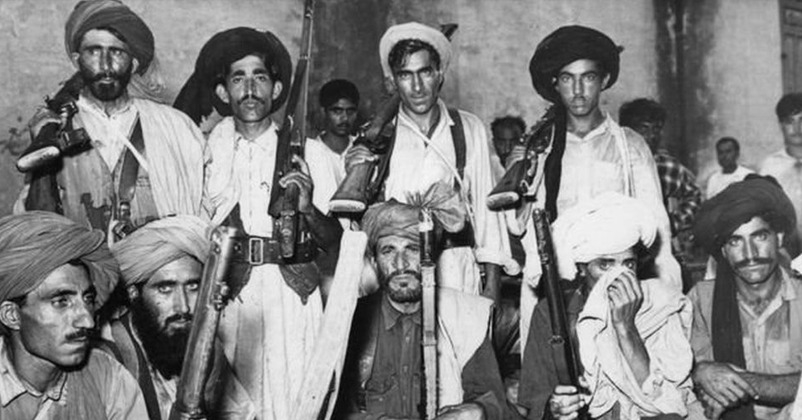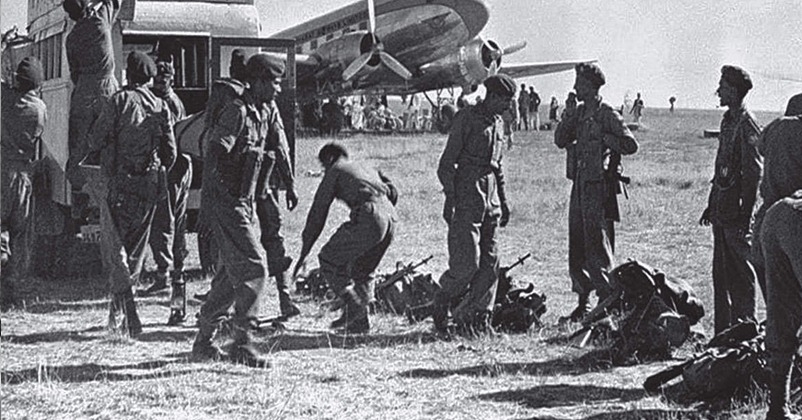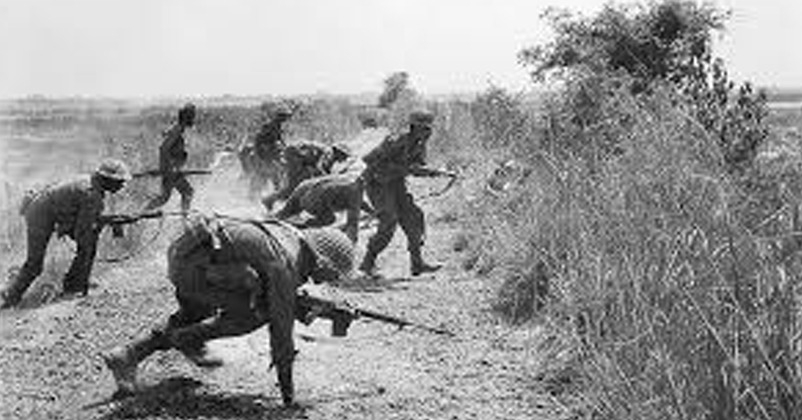History #Revision: When rattled Pakistan began invading Jammu and Kashmir in 1947 (Article 6)
| 29-Nov-2022 |

Major-General Kalwant Singh, General Officer Commanding, Jammu & Kashmir Division, issued orders on 16 November 1947 for the rapid relief of Naushahra, Jhangar, Kotli, Mirpur and Poonch. To achieve this object, the operations were to be carried out as follows:
(a) A force from 50 Para Brigade and attached troops, under command of Brigadier Paranjape was to move at 0600 hours on 16 November with the utmost speed on axis Akhnur-Beri Pattan, Naushahra, Jhangar and thence to Kotli and to Mirpur. Naushahra was to be secured on 16 November, a firm base established at Jhangar on 17 November, Kotli relieved on 18 November, and Mirpur relieved at least by 20 November.
(b) A force consisting of two battalions of 161 Infantry Brigade and attached troops, under Brigadier L.P. Sen was to strike from Uri on 18 November towards Poonch, arriving at Poonch on the same day. A detachment of 16l Brigade and attached troops were to advance south from Poonch and effect junction at Puri with Paranjape's force. After reinforcing the Poonch garrisoon with one battalion, the rest of Brigadier Sen's force was to withdraw to Uri.
(c) 268 Infantry Brigade (then being formed and consisting of 1 Patiala and 1 Madras) was to take over protection of the line of communication from 0600 hours on 17 November as under:
(1) Jammu-Kathua
(2) Jammu-Banihal
(3) Jammu-Beri Pattan
1 Patiala was to establish a company firm base at Beri Pattan and protect Paranjape's line of communication Jammu- Akhnur-Beri Pattan An air striking force operating from Jammu airfield was required to provide air support to 50 Para Brigade. It was the intention of Air Headquarters to move No. 7 RIAF Squadron Detachment from Amritsar to Jammu and the Harvard Flight of No. 1 RIAF Squadron from Srinagar to Jammu, as soon as the Jammu airfield was considered fit for use. The Jammu airfield was 885 metres long; it was to be extended to 1275 metres.

Major-General Kalwant Singh's plan was adversely commented upon by General Bucher. The tasks outlined in that plan far exceeded the instructions conveyed to Major-General Kalwant Singh according to the decisions of the Defence Committee of the Cabinet meeting held on 14 November. Bucher was of the view that the uncoordinated advance Or the two columns--one from Jammu and the other from Uri-was positively dangerous, especially as the former column was still held up in the vicinity of Beri Pattan.
The advance of the column from Uri to Poonch, with enemy still in position, appeared to him almost fool-hardy. India could not afford to take risks that might result in even a minor set- back. Should India be involved in any setback, then any prestige established by the successful action in Kashmir would be dissipated in a flash.
In his reply to Delhi and East Punjab Commander on 20 November, Major-General Kalwant Singh pointed out that, in view of the delayed advance of 50 Para Brigade, he had already ordered Brigadier Sen on 17 November to stop the advance from Uri to Poonch. He further added that he had discussed with Lieut-General Russell the problem of the despatch of a strong force from Uri to Poonch and the latter had agreed to the suggestion.
Commander 50 Para Brigade also disagreed with the Divisional Commander's plan on several points. He felt that no advance to Kotli and Poonch should be undertaken without thorough preparation and without making Jhangar a firm base. Pakistani raiders were present in considerable numbers throughout the area and could interfere seriously with the long line of communication from Jammu to Kotli and Poonch, running parallel to the Pakistan border within only a day's march from it.
Besides establishing a-firm base at Jhangar, it was prudent to relieve and hold in strength Mirpur also before proceeding to Kotli, as the fall of Mirpur to the raiders would immediately expose the Jammu-Kotli road to the raiders' attacks. The dates laid down for the relief of the various places also appeared unrealistic to Brigade Commander, since no exact information was available regarding the raiders' strength, destruction of bridges, number of enemy roadblocks on the road, etc. Furthermore, the troops available to him were, in his opinion, quite insufficient for establishing control over the area upto Kotli and Poonch with a firm grip on the vital L of C.
50 Para Brigade was much below its normal strength, as 1/2 Punjab and 3 (Para) Rajput had only about 350 to 400 men each due to the fact that their pre-partition Punjabi Mussalman companies had gone over to Pakistan. 50 Para Brigade in fact had only five rifle companies, plus some supporting arms at the beginning of the advance to Kotli.
Commander 50 Para Bde was of the view that two battalions and two squadrons of armoured cars were required to keep the road open from Kathua to Srinagar, while a further three battalions and mountain batteries were required to maintain law and order in Jammu and relieve the State Force garrisons in Punch and Mirpur sectors.
For firmly holding Jhangar alone, he considered it necessary to picquet the surrounding heights with eight rifle companies, or two battalions, with a third battalion in reserve there. Naushahra, in his opinion, could be held firmly with much less troops.
_202211291844198072_H@@IGHT_420_W@@IDTH_802.jpeg)
ADVANCE TO KOTLI
At 1045 hours on 16 November B company 1 Patiala secured Beri Pattan for the advance of the column of 50 Para Brigade. The forward platoons were fired upon by raiders. They were engaged by 3-inch mortar and small arms fire and withdrew after suffering casualties.
Having prepared the way for the advance of 50 Para Brigade, 1 Patiala passed under command 268 Brigade at 1930 hours on 16 November.
HQ 50 Para Brigade arrived at Beri Pattan at 1600 hours o n 16 November. It was held up there owing to the ford not being ready. Engineers considered that the ford would be ready for jeeps and light vehicles by 1200 hours o n 17 November. A platoon of 14 Field Company which had arrived at Jammu during night 16/17 November was despatched to Beri Pattan to help in the task of making the ford ready. It found there a drop of nearly 9 metres to the water level.
The shallowest part of the stream selected to throw rubble and stones into the water was about 60 cm deep. The light vehicles were pushed and pulled through with ropes attached, and thus these vehicles were got across by the afternoon of 17 November. The forward battalion of 50 Para Brigade crossed the ford at 1730 hours on 17 November. Tactical reconnaissance over the road Beri Pattan-Naushahra revealed several roadblocks.
The column, however, pushed on to Naushahra, leaving Brigadier Paranjape with only 3 rifle
companies and some MMG and a troop of 25-pounder guns at Beri Pattan, together with all the transport with rations, ammunition and kit. The State forces at Naushahra had already repulsed an enemy attack during the night 16/17 November with casualties to the enemy.
Enemy at Naushahra fled after a brief engagement on 18 November.
On the 18th, the troops remained at Naushahra, as ordered by Brig Paranjape, who did not want to advance with only two companies and without knowing the situation between Naushahra and Jhangar. Gen Kalwant Singh wanted Brig Paranjape to take Kotli on the 19th, so the latter, contrary to his inclination, advanced to Jhangar without being joined by the battalion at Naushahra. The advance to Jhangar was resumed at 0700 hours on 19 November and Jhangar was occupied without opposition.
The advance to Kotli was, however, slowed down by numerous roadblocks and heavy sniping. On 20 November 1/2 Punjab advanced from Jhangarto a place about 16 km further on, and Paranjape's Bde of five rifle companies was then stretched from Beri Pattan to 16 km beyond Jhangar i.e. about 64 km. 3 (Para) Rajput and the rest of the troops arrived at Jhangar on the night of 20 November.

On 21 November the advance of 1/2 Punjab-the forward battalion- was held up by strong opposition about 24 km north of Jhangar." A troop of armoured cars gave covering fire and the opposition was overcome. At 0800 hours on 22 November Indian troops attacked and captured a strong enemy position about 3 km north of Dungi.
The advance continued in spite of heavy sniping and the forward troops were about 27 km north of Jhangar. On 23 November the advance was slowed down owing to the increased enemy sniping and roadblocks. On 24 November, tactical reconnaissance reported enemy digging near Ban bridge south of Kotli. On 25 November intelligence reports revealed that approximately two hundred hostiles had concentrated in Kotli with automatics and one mortar.
On 26 November a strong enemy position north of Ban bridge was captured and Indian troops entered Kotli at 1420 hours on 26 November, having completed an advance of 147 km from Jammu. Brig Paranjape found in Kotli about two companies of Kashmir State troops and one company of Kashmir State Muslim troops who had been disarmed. The garrison's stock of ammunition was low. Their morale was lower and the men were drinking water out of filthy ponds in the town and did not go out for clean water or personal ablution. There was a demoralised civil population of 9,000.
The Indian force approaching Kotli from the south encountered forty-seven roadblocks in the defile through which they had to advance. These roadblocks consisted of felled trees, ditches dug across the road and damaged culverts. With steep hills on one side and a ravine on the other, the Jhangar-Kotli road easily lent itself to this form of delaying tactics. Had the enemy covered even a quarter of his forty-seven road- blocks with fire, the advance would undoubtedly have been more costly. The enemy in the Kotli area proved to be a poor marksman and indifferent tactician. Apparently his force did not include the Pathan element or trained regulars yet.
The garrison at Mirpur could not be relieved. Mirpur, which according to refugees, was evacuated on 25 November, was in flames on 26 November. On 26 and 27 November Indian patrols based on Jhangar brought in a number of refugees, who had escaped from Mirpur, and they also killed some of the enemy near a broken bridge, about 8 km from Jhangar.
As information had been received that the column advancing from Uri to Poonch had been attacked by the enemy and compelled to return to Uri, the idea of the advance from Kotli towards Poonch was given up. Owing to the vulnerability of the long line of communication from Jammu after the fall of Mirpur, it was decided not to hold Kotli but to fall back on Jhangar, after evacuating the refugees and the State force garrison at Kotli. This was successfully accomplished on 28 November. Brig Paranjape relinquished command of 50 Para Bde soon after.
(Excerpts have been taken from "History of Operations in Jammu and Kashmir 1947-48”)
To be continued…………….